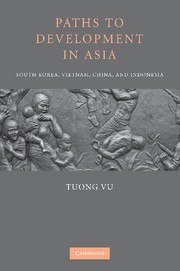Book contents
- Frontmatter
- Contents
- List of Tables and Figure
- Acknowledgments
- List of Abbreviations
- 1 State Formation Dynamics and Developmental Outcomes
- PART ONE DIVERGENT NATIONAL PATHS OF STATE DEVELOPMENT
- 2 South Korea: Confrontation and the Formation of a Cohesive State
- 3 Indonesia: From Accommodation to Confrontation
- 4 Rival State Formations in China: The Republican and Maoist States
- 5 Vietnam: Accommodation and Arrested Revolution
- PART TWO VARIANTS OF ACCOMMODATION: VIETNAM AND INDONESIA COMPARED
- References
- Index
3 - Indonesia: From Accommodation to Confrontation
Published online by Cambridge University Press: 04 August 2010
- Frontmatter
- Contents
- List of Tables and Figure
- Acknowledgments
- List of Abbreviations
- 1 State Formation Dynamics and Developmental Outcomes
- PART ONE DIVERGENT NATIONAL PATHS OF STATE DEVELOPMENT
- 2 South Korea: Confrontation and the Formation of a Cohesive State
- 3 Indonesia: From Accommodation to Confrontation
- 4 Rival State Formations in China: The Republican and Maoist States
- 5 Vietnam: Accommodation and Arrested Revolution
- PART TWO VARIANTS OF ACCOMMODATION: VIETNAM AND INDONESIA COMPARED
- References
- Index
Summary
POLITICS OF ECONOMIC SWINGS
Indonesia experienced a more tortuous trajectory of development than did South Korea. During the first four decades after independence, the Indonesian economy underwent two major pendulum swings. In the first seven years following independence, the Indonesian economy experienced moderate growth, estimated between 3 and 5.5 percent per year (Higgins 1957, 48; Paauw 1963, 189, 200–1; Mackie 1971, 19; Booth 1998, 61). Growth was highest in the first two years of this period, thanks to the Korean War that led to booming demands and favorable prices for Indonesia's primary exports. Although Indonesia faced a growing budget and foreign exchange crisis in late 1952, the economy continued to grow moderately because of government retrenchment policies, including import restrictions, export promotion, fiscal austerity, and foreign exchange controls (Higgins 1957, 1–39).
In 1957 ultranationalist politicians under Sukarno's leadership rose to power and decided to nationalize most foreign enterprises. Under conditions of poor Indonesian management and insufficient credit, the performance of these enterprises, which made up the backbone of the modern sector, worsened. An unrealistic exchange rate, government hostility to foreign capital, inflationary government spending, and large military expenditures were additional factors that devastated the economy (Dick 2002, 182–90). By 1965 the country was practically bankrupt with inflation rates surpassing 500 percent and budget deficits equal to 300 percent of receipts (Hill 2000, 1).
- Type
- Chapter
- Information
- Paths to Development in AsiaSouth Korea, Vietnam, China, and Indonesia, pp. 50 - 70Publisher: Cambridge University PressPrint publication year: 2010



